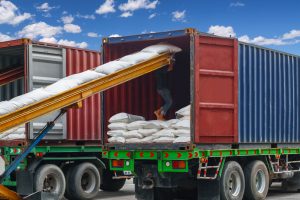Fixing supply chain woes a balancing act
By Tammie Sloup FarmWeek — November 23, 2021
From exporting crops to importing active ingredients for crop protection materials, the agriculture industry is feeling the pain of the supply chain backup.
The truck driver shortage and congestion at the nation’s largest ports in California often dominate discussions about the supply chain crisis, but experts say that’s oversimplifying the problem.
“There are a sequence of events, and I think if you take a broader view on the supply chain, so beyond just the logistics side, it is the weather, it is the geopolitics, it is a lot of these exogenous factors, which are very hard to plan for as well,” said Sam Taylor, farm inputs analyst for Rabobank’s RaboResearch Food & Agribusiness, who spoke during a Farm Journal webinar recently concerning supply chain issues.
From exporting crops to importing active ingredients for crop protection materials, the agriculture industry is feeling the pain of the supply chain clog, which is expected to last into the new year.
“I had not really understood well, until this summer, how short we are on active ingredients, and the difficulties of getting active ingredients into these plants to produce things like crop protection chemicals. … These changes take a long time to reset,” said Allan Gray, director of the Center for Food and Agricultural Business at Purdue University.
But it’s not a dire situation for farmers, Gray said.
“We’re going to do it differently,” he said. “We’re going to choose active ingredients we haven’t used before, we’re going to do different kinds of production activities that we haven’t done before, or haven’t thought about before.”
President Joe Biden has said the $1 trillion infrastructure bill includes $17 billion to improve ports and entry points along the U.S. border.
USDA’s chief economist, Seth Meyer, said the department is meeting with constituencies trying to identify short-, medium- and long-term actions that government can take, but tackling the overall supply chain issue is a balancing act.
“Me as an economist is saying, ‘Hey, let’s make sure we don’t improve the flow of one good and then have difficulty getting truck parts from overseas,’” Meyer said. “So, you’re trying to balance all of these things in a very tight supply chain.”
In the meantime, the panel encouraged farmers to maintain and improve communication with customers and other partners, and plan for the planting season as soon as possible.
Asked whether fertilizer prices will come down in time for the 2022 season, Taylor said it’s unlikely.
“I would say if there’s one thing that might come down potentially it’s potash, given the fact that a huge amount of this is driven by sentiment driven by the concerns about Belarusian production, how much of that is getting onto the global market versus staying in Belarus,” he added.
Also, the higher fertilizer prices have less to do with shortages and more with natural gas prices driving nitrogen prices, Gray added.
“That combined with corn prices being higher, those two variables are the predictors of nitrogen prices. Our nitrogen prices are high not because we’re out of supply, but because natural gas is expensive,” he said.
Asked what measures they would prioritize to clean up the supply chain situation, the speakers agreed freeing up the bottlenecks at the West Coast ports is a starting point, while farmers’ focus should be on crop solution planning.
From a policy perspective and related to the ports, Gray asked the question, “Are there pressure valves we can release?”
He pointed to a recent executive order allowing businesses to stack additional shipping containers in Long Beach, temporarily lifting height limits to help ease the backlog of ships.
“Maybe they’re temporary pressure valves, but they’re places where regular regulatory is having an impact on our supply chain, and there’s opportunities to release some of those pressure valves to try to have some impact on what’s happening there.”
Clearly there are challenges that can’t be solved in the short term, such as the labor shortage, he said, but simple, practical measures can go a long way.
This story was distributed through a cooperative project between Illinois Farm Bureau and the Illinois Press Association. For more food and farming news, visit FarmWeekNow.com.







